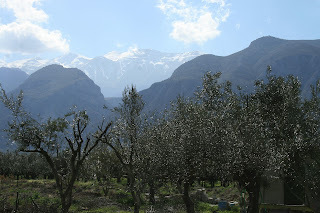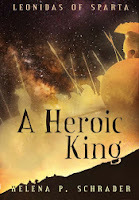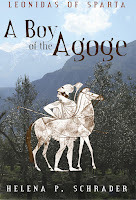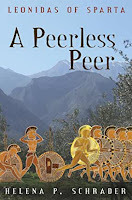Settings that Inform
The encounter with Sparta that changed everything.

Even someone who has never studiedSparta or read a single book about it has images of Ancient Sparta transmittedthrough our language alone. “Spartan” isan adjective used to denote “severe,” “plain,” and “austere.” Laconic speech is“terse,” “concise” and “economical.” The most rudimentary and fleeting brushwith Sparta inliterature almost invariably includes reference to rigid discipline, disdain forluxury, self-sacrifice and endurance of hardship.
The more one looks into Spartan society, the quicker he/she isconfronted by references to a childhood of deprivation in which one had tosteal to get enough to eat and was allowed only one garment per year. The boys,we learn, had to cut down the river reeds with their bare hands or the help ofa tool which is dismissed as practically worthless, and then sleep upon theseinstead of real beds. Worse, they had to live practically in the wild, exposedto the elements without shelter or proper clothes. Books like Gates of Fire describe horrendous beatings to which Spartan boyswere apparently subjected for any tiny infraction of the rigid rules ofacceptable behavior.
Nor are youths the only Spartans whom, we are led to believe, suffereddeprivation. This was a society, according to most sources, where women wereprohibited from wearing jewelry or even taking pride in their weaving. Indeed,all gold and silver was banned, and so could adorn nothing - not even thetemples of the Gods. The houses, we aretold, were not painted (as else where in the Ancient world), and if onebelieves the oft quoted “sayings of Spartan kings” they did not even hew theirhouse beams into regular square posts, but left them raw and untreated – oneimagines crude timber as in a log cabin. Meanwhile, the young men lived inbarracks (notoriously grim places in any society!) and for their entire livesate their meals at men’s clubs where the cuisine, we soon learn, was infamousthroughout the ancient world for its lack of sophistication and variety.
In short, it sounds like a society barely surviving in a hostileenvironment, a society which had made a virtue out of necessity.
And then I went to Sparta... As I drove down the modern road from Tripoli (or Tegea as I prefer tothink of it) toward Sparti (Sparta) there came a moment when coming around a bend I caught the first glimpse of the Taygetos mountains. The view took my breath away. I could hardly concentrate on the winding roadfor straining to get another glimpse of those spectacular, snow-cappedmountains. When after another twenty minutes of driving the valley of the Eurotas spread out before me, it was a revelation. My image of Sparta – AncientSparta and all that Spartaimplied – was transformed in a single instant.
The valley of the Eurotas is anything but barren! It is quite thereverse. It is green and fertile and stunningly beautiful -- like riches cuppedin the hands of the gods. From the blooming oleander to the wild iris, thevalley is a garden. The orange orchards stretch as far as the eye can see,brazenly advertising not only the abundance of soil and sun but of water as well.Most spectacular of all, the Eurotas valley is one of those few places on earththat offers the sensually stimulating sight of palm trees waving against aback-drop of snow-capped mountains.
I asked myself: has Laconiaperhaps changed dramatically in the last 2,500 years? Was it poor when theharsh, economical, self-disciplined Spartan society took root in its -- then -- sparse and almost barren soil? Does itbloom now artificially because of modern fertilizers and irrigation?
If we are to believe the ancient historians, no. Herodotus speaks of Sparta’s “good soil”. Thucydides describes the entire Peloponnese (with the exception of Arcadia) as the “richest part of Hellas.”It is when speaking of Athens, that Thucydides draws attention to “the poverty of her soil.”
So the fertility and abundance of the valley has not changed sinceAncient times any more than the shape of the mountains that enclose it. But if this rich valleywas the seat of Sparta,then Spartan austerity and deprivation did not come from necessity! If Sparta’s land was rich,fertile and productive, then it could have enabled the highest standard of livingavailable in the ancient world -- at least to the always modest number of eliteSpartiates. In short, if Spartawas as austere a society as it is depicted in modern times, then that austeritywas self-imposed.
Is it reasonable to imagine that a people raised in the midst of wealth and beauty had no appreciation for either? Or is the very austerity of Spartan society as mythical as the thin soil described in modern novels about Sparta? I started to wonder if our images of a rigid, harsh and brutally disciplined society were a distortion or exageration? A fractured image? A misunderstanding based on ignorant,or prejudiced foreign reporting? Imagine what American society looked liked through the eyes of the Soviets or the Taliban!
That was when I started to seriously research Ancient Sparta, focusing on ancient sources, primary sources, archaeology and and scholarly works. I soon discovered a different world from that of Hollywood, Stephen Pressfield and the global fascist movement that has expropriated so many Spartan symbols. Following extensive research, participation in scholarly fora, and personal contact with some of the leading modern scholars of Ancient Sparta, I have come to believe that popular modern images of Sparta are based largely on inadequate, hostile and sometimes purely fanciful source material. So I set out to describe a different Sparta, a Sparta consistent with the ancient sources, but enhanced by common sense interpolation and an understanding of human nature. On the assumption that exaggerations and myths often have a kernel of truth, I did not turn Sparta into paradise of luxury and self-indulgence, but sought instead to provide logical explanations of where the legends might have had their roots in a normal, if unique, society. This Spartan world is depicted in my six novels set in Ancient Sparta, which have been praised by scholars for their plausibility and contribution to an understanding of the real Sparta. Herodotus, Book I.66,p.26. Thucydides, Book I.2,p.36. Ibid.
Find out more about my novels set in Ancient Sparta at: https://helenapschrader.net/ancient-sparta/



Published on August 25, 2025 02:35
No comments have been added yet.



